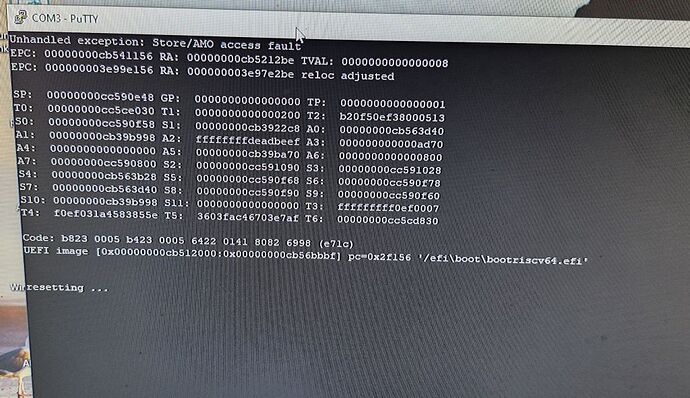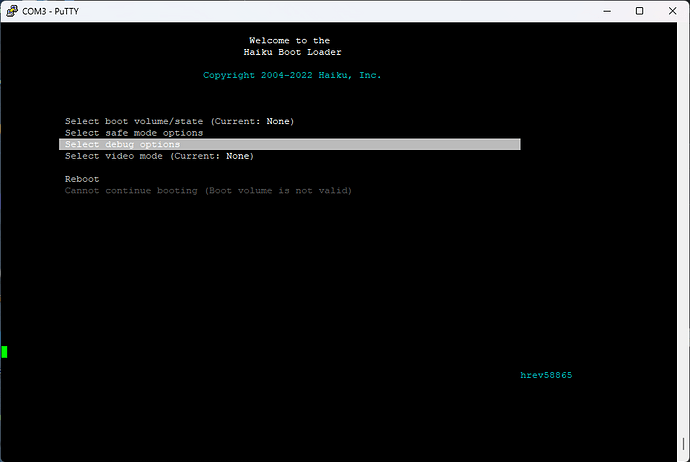I knew these RISC-V laptops/tablets like DC ROMA would quickly go out of date, as CPU & boards are updated. So I got the Crowview Note portable monitor in laptop form, that you can connect (cheaper) boards to - so it won’t go out of date. Now just waiting for the next round of new boards to come out (with more power). e.g., Sipeed has a Lichee 5A RISC-V board as its next release.
Did anyone ever succeed in getting the kernel happy with the memory map of the Allwinner D1 SOC used in the Mango Pi and Nezha?
I know that was worked on a little bit but hasn’t been the primary focus of porting, and I’m curious how far it is from functional because I own a Mango Pi MQ-Pro, and if I were to jump in the fray in any capacity myself, that is what I’d want to work with.
I once managed to run Haiku kernel on Mango Pi, but I failed to make USB working, so it can’t find boot partition. That CPU use special non-standard page attributes for memory caching etc options that are required to be properly configured by OS, otherwise MMIO and atomic memory operations will not work properly.
It’s happend ![]() Indrustrial risc-v Banana Pi BPI-F3 | BananaPi Docs
Indrustrial risc-v Banana Pi BPI-F3 | BananaPi Docs
The Milk-V Megrez, Mini-ITX, board has some good specs:
- up to 1.8GHz, Quad Core SiFive P550
- IMG AXM-8-256 GPU
- Up to 19.95 TOPS NPU
- 28% CPU Frequency Boost
- Linux OS & software support
- RISC-V Hypervisor (H) extension, allows RISC-V hardware to natively support hypervisors running multiple Virtual Machines (VMs).
Would this board - with hypervisor extension - be better for testing Haiku on, since Haiku is booted via a VM / miniVM?
I bought the VisionFive 2 ages ago because it has a GPU and seemed quite promising. Unfortunately, Imagination has yet to provide a proper driver for that GPU.
What will the Milk-V Megrez’s support be like? It too has a GPU from Imagination. Perhaps the GPU performance is supposed to be imaginary.
When i use a hrev58684 in VisionFive2, when load haiku uefi made a screen
And I think do upload new U-boot rom? I It’s correct?
Please Help!
I see a deadbeef in register A2. That looks like it probably comes from the new bootloader heap logic that overwrites memory on free().
And now present a orange pi rv2
http://www.orangepi.org/html/hardWare/computerAndMicrocontrollers/details/Orange-Pi-RV2.html
How doing work @ smt riscv ? Now I preset you a 64 core system
I’d love to run Haiku on RISC-V hardware.
64 cores will do next to nothing to improve performance. CPU performance is primarily determined by a CPU’s single-threaded performance. This fact will never change because a lot of tasks simply can’t be parallelized.
Is X512 focusing on Haiku Nvidia driver instead of RISCV port these days?
In Haiku it is not so difficult to run a few hundred threads. Not for a single task, but for doing many things at once with your computer.
And even when doing a single task, if it’s something like compiling a large software project (like Haiku or WebKit), having several cores each working on a .cpp file will help a lot.
I was able to switch my Milk-V Pioneer over to EFI booting rather then using Linuxboot.
Reference: EDK2 first boot - Pioneer - Milk-V Community
I was able to finally boot in the Haiku boot loader, but haven’t made it past due to some issue about it not finding a valid boot device.
I’m never completely comfortable connecting various hardware directly to a valuable system. I much rather prefer to implement GPIO interfaced stuff to Arduino/ESP-xxx/Pico1or2 and then connect to apps on the Haiku system via USB or WiFi.
I prefer using microPython and generally expose functionality via REST interface. So much easier to debug both on the microcontroller and the host system.
I’m curious about the Risc V and other ARM progress. Has anyone been able to boot Haiku on any Pi (or Pi like SOC?) based upon ARM architecture?
I’m also very curious about the experiences of you readers of this forum - what is the absolutely lowest power consumption hardware that can run Haiku natively that is currently in production (so, no systems older than say, 12-24 months) ?
No, it has not booted to an usable deskop on ARM. Only x86, x86_64 and RISC-V get that far.
Thanks for the reply @pulkomandy, I’m curious if you can outline the blockers for someone who is savvy with software development language, but is not a developer
- What stops the booting?
- What drivers need development?
- What kind of coders do you need to get that section of code written and how much would they cost?
I dont have $ but I’m thinking that Haiku would be an exceptional base for the most lowest wattage processors on the market. My use case specifically would be super cheap, low power desktop pcs that could run for 12-24 hours a day on solar + battery only. Developing nations, remote outposts etc.
Ive been a beos fan since 1997. got all the books manuals, audio software etc. i helped kabunkie develop a scanner and pcie card drive way back when
Haiku has the obvious advantage of efficiency, low cost, open source code plus the fact it isnt half of a 100 linux distros.
I see annual donation aim is $30k usd… what could be achieved if it were $300k or even 1mil? I imagine attracting talent for a very niche OS in C++ would be difficult to hire for… or am I mistaken?
Keen to hear all comments. Also great news to hear it boots on Risc V. Is Risc V lower power consumption than ARM?
Probably some of the existing developers could leave their current paid job and work full time on Haiku instead.
Personally I don’t want to do that in the current situation, since the contract would only last maybe a year or two, and then stop.
Also note that the current 30K goal is very low compared to market rates for skilled developers. Normally it wouldn’t allow to pay for one or even half of one. Our current paid one (waddlesplash) has decided to accept that with the goal to advance Haiku.
Currently I think it’s low level stuff like MMU management that needs some fixes. After that will probably come finalizing the SDHCI driver and writing an eMMC one. After tha, each ARM board is specific and this will need massively more drivers than x86, where, at this point, everything is either standard protocols (like USB), or there are only 2 or 3 vendors so only 2 or 3 drivers needed.
You may want to try something like Linux, because it has power management and sleep capabilities far better than Haiku currently does. Or, if you really want to use Haiku, you have to also add all the work for power saving on top of the other things to develop.
Both of them are entire families of CPU architectures and even instruction sets implemented by many manufacturers, with a wide range of choices, and different compromises of power saving vs performance. You will have to look more specifically at some CPU models for an useful comparison.


